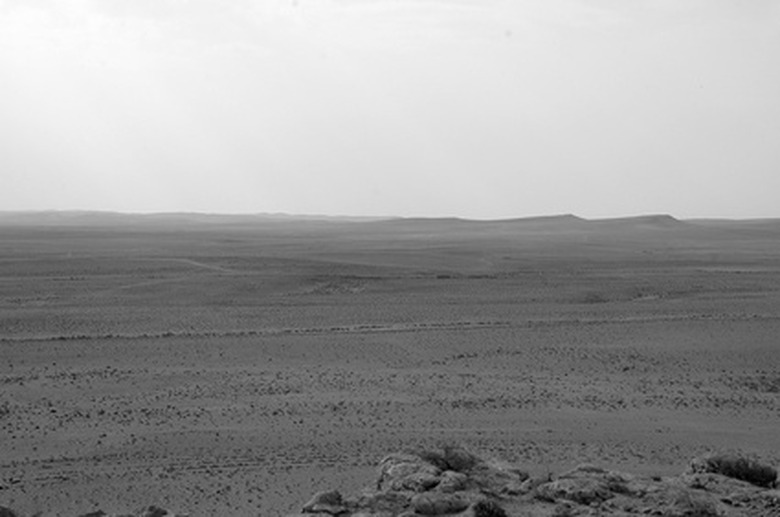Facts About Australian Deserts
If any country knows anything about deserts, it's Australia. The giant continent is surrounded by water, but nearly one-fifth of the country is considered desert. In fact, it's the driest inhabited continent on the planet; only Antarctica is drier. Incredibly, all kinds of plants and animals have found ways to survive even amid the harsh conditions of the outback. The more Australian desert facts you learn, the more amazed you'll be at how different creatures learn to thrive out there in the wild.
TL;DR (Too Long; Didn't Read)
Australia's 10 deserts are usually hot and dry, but visitors are still drawn to them to see gorgeous red sand dunes as well as animals like dingos and thorny lizards that have developed adaptations to survive in the harsh conditions.
The Most Popular Deserts
The Most Popular Deserts
If you looked at an Australian desert map, you would see that Australia has 10 different deserts spread throughout the country. The biggest and most well-known is the Great Victoria Desert, which stretches for more than 400 miles through Western and South Australia. Not many people live in the Great Victoria desert, but some do, many of them Indigenous Australians whose ancestors lived on the land before the British arrived.
The Simpson Desert is also well-known, likely thanks to its striking red sand dunes. It is located in the middle of the country. In the summer, temperatures can climb to more than 120 degrees Fahrenheit, and the area can also be home to dangerous sand storms. Still, the Simpson Desert is a popular tourist attraction, especially for people who want to see the natural springs that act as an oasis amidst the arid, dusty climate.
Another popular tourist destination is the Uluru-Kata Tjuta National Park, which is in the Great Sandy Desert. The park is home to the Uluru and Kata Tjuta red rock formations, which rise impressively over the stark desert landscapes.
Harsh Conditions of Australian Deserts
Harsh Conditions of Australian Deserts
Like other deserts around the world, Australian deserts are home to pretty harsh conditions. If you're planning a trip to the Australian deserts for kids, you might want to think again – it can be pretty rough out there. In the summer, most of Australia's deserts see temperatures around 100 F or even higher.
It might also surprise you to learn that many of the deserts in Western Australia have thunderstorms, but they look a lot different than the ones you might be used to. They are called dry storms, where most or all of the rainfall evaporates before it hits the ground, but you can still see the cloudy skies, experience high winds and hear thunder rumbling through the arid desert. More dangerous than those dry storms are sand or dust storms, which is what happens when high winds blow around extreme amounts of dust or sand. This can cause problems with visibility, or make it difficult for people to breathe if they are unlucky enough to be caught up in such a storm.
Australian Desert Biome
Australian Desert Biome
As harsh as the conditions are, there are plants and animals that have adapted to the tough way of life in Australian deserts. Like many deserts, Australian ones have several types of cacti and shrubs that have developed adaptations like thorns and water storage systems to help them survive despite the lack of rain.
Lizards are one of the most common creatures in Australian deserts. Many lizards have tough skin that doesn't sweat, and wily tongues that can catch water from dew drops, so they are great at conserving the little water that they need to survive. Australian thorny devils are small lizards whose thorny exterior acts as a defense mechanism against the bigger lizards. Anyone familiar with Australian outback facts might also recognize the dingo. These wild dogs live all over the country, but the dingos in the desert have developed a lighter color and a thinner coat so as not to absorb too much desert heat. The country's most well-known animal, the Big Red variety of kangaroo, is also a product of the desert. It developed its hopping mechanism because it's a very efficient way to get around. They can cover a lot of ground in big hops without expending much energy, meaning they don't need as much water or food as other animals do to survive.
Cite This Article
MLA
Dragani, Rachelle. "Facts About Australian Deserts" sciencing.com, https://www.sciencing.com/australian-deserts-6688517/. 22 November 2019.
APA
Dragani, Rachelle. (2019, November 22). Facts About Australian Deserts. sciencing.com. Retrieved from https://www.sciencing.com/australian-deserts-6688517/
Chicago
Dragani, Rachelle. Facts About Australian Deserts last modified March 24, 2022. https://www.sciencing.com/australian-deserts-6688517/
